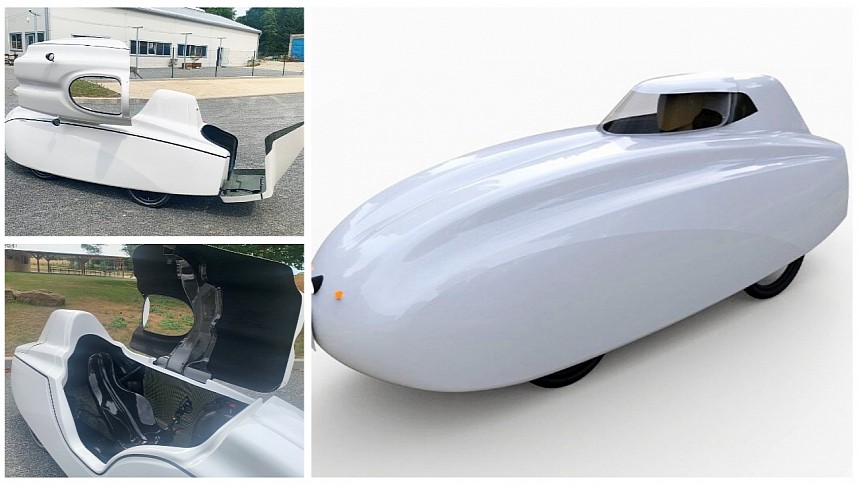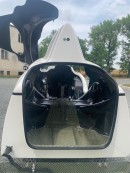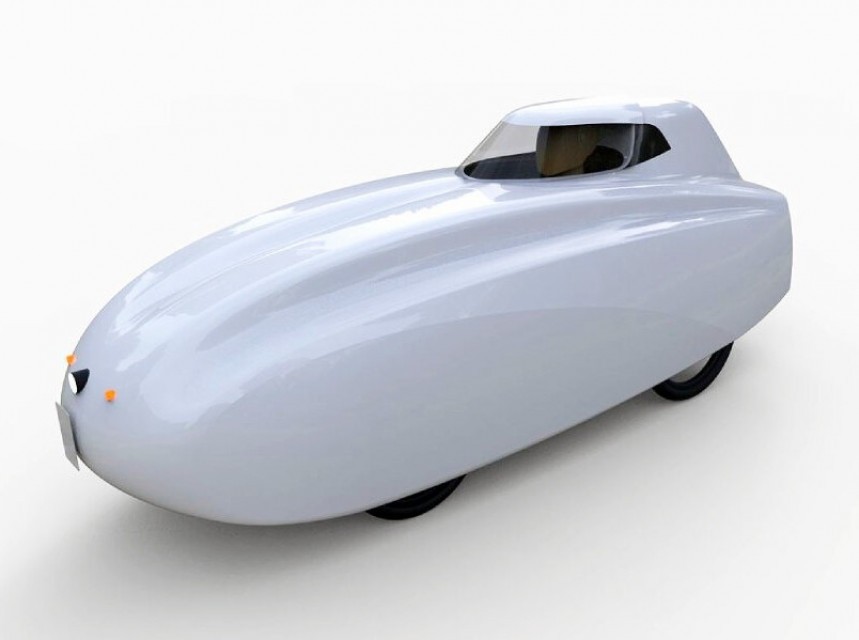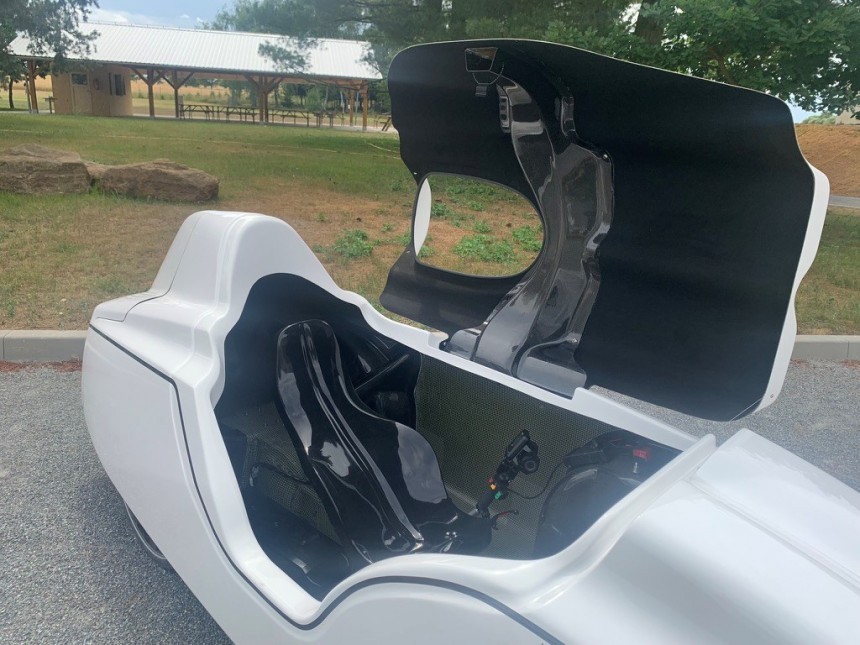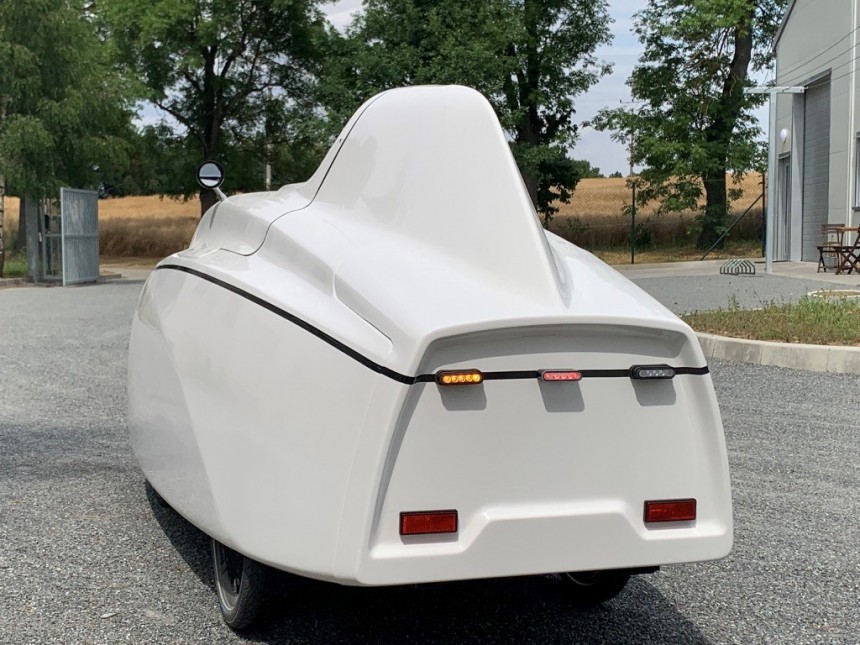What's better than an electric bicycle because it offers protection from the elements and a higher top speed, and better than a car because it's smaller, greener, and less fussy in terms of maintenance? The Katanga VM45 would like to be the answer to this question.
The VM45 is the latest model from Czech company Katanga and is described as a hybrid between a sporty velomobile and a small electric car, offering the advantages of both in a compact, lightweight, and very aerodynamic package. It's not a production model as of the time of press, but a working prototype that started road testing last month – but it's worthy of attention given Katanga's plans to bring it to market.
The reality we're dealing with is that our cities are getting more crowded and more polluted by the day, and it doesn't seem like there's any solution in sight for the immediate future. Electric vehicles are one proposed solution, but they still take up space and require an infrastructure that's far behind the developments of the EV industry.
Electric bicycles are also a possible solution, but they, too, come with downsides, from issues with storage, infrastructure, and the lack of regulation for parts, which has led to an increase in the number of fires caused by them. On an everyday base, few riders would want to get wet in a downpour or arrive to work frozen stiff because bicycles don't provide protection from the elements.
Katanga believes that a cross between these two segments could work. Katanga has considerable experience with velomobiles, recumbent tricycles developed for speed thanks to an enclosed body. It's using that experience to inform the development of this hybrid vehicle called the VM45.
The VM45 is half velomobile because it's a recumbent bike with an enclosed shell. The VM45 is also a mini-EV because it uses a mid-drive 750W motor to move at speeds of up to 45 kph (28 mph), which is more than you could ever get while riding assisted on an electric bicycle in the European Union. EU member states have the speed for e-bikes capped at 25 kph (15.5 mph), so the most common motor option on these machines is the 250W one.
The VM45 rides on four wheels instead of three for maximum stability at this speed and when cornering. Peak power of the motor is 1500W with 130 Nm (95.8 lb-ft) of torque. The Valeo-Cyclee Mid-drive drivetrain features automatic shifting with seven speeds and reverse drive, and a differential that sends power to the rear wheels.
The 48V 1240Wh battery provides a minimum of 120 km (74.5 miles) of range. In eco riding mode, which means the mode with the highest level of pedaling input from the rider, per-charge range is 255 km (158.5 miles).
The rider sits recumbent inside the cockpit on an adjustable mesh seat. There's considerable storage space in the back, which gives the VM45 yet another edge over the standard two-wheel e-bike. No matter how many bags or crates you attach to it, you can't beat the comfort of a trunk. Maximum payload is 121 kg (267 lbs), including the rider's weight, while the machine itself tips the scales at 79 kg (174 lbs).
The VM45 comes with front and rear lights, indicators, side mirrors, and a motorcycle horn. The shell is made of composite, with a removable cockpit window for when you want to feel the breeze (and bugs?) on your face. Katanga president Stephane Boving recommends riding the VM45 with a bicycle helmet, though that will probably offer little assistance in a worst-case scenario. There's no mention of how much protection the VM45 body would offer in case of a crash.
The EV gets double suspension, lower in the front and higher in the rear to offer maximum comfort and stability on the road. Two different types of brakes are used, 90mm drum brakes for the front wheels and 160mm disc brakes in the rear, which double as parking brakes.
And now for the bad news. In this configuration, the VM45 doesn't qualify as an e-bike but as a lightweight on-road quad (L6e-A category), which limits availability because it will require proper certification – though not necessarily a permit in order to ride it. Katanga is considering offering a more accessible, lower-specced 250W version or even a motor-less model that would allow riders to use it on pedal only or to fit it later with a motor of their choice.
Another piece of bad news is in regard to pricing. Katanga estimates an MRSP of €11,000 for the non-motorized model and €13,000 for the motor-assisted VM45, assuming it ever reaches mass production stage. That's $12,000 and $14,300, respectively, at the current exchange rate, and arguably more than you'd pay for any electric bicycle designed for daily use. Or even for a second-hand car, if you're not particular about driving electric.
The reality we're dealing with is that our cities are getting more crowded and more polluted by the day, and it doesn't seem like there's any solution in sight for the immediate future. Electric vehicles are one proposed solution, but they still take up space and require an infrastructure that's far behind the developments of the EV industry.
Electric bicycles are also a possible solution, but they, too, come with downsides, from issues with storage, infrastructure, and the lack of regulation for parts, which has led to an increase in the number of fires caused by them. On an everyday base, few riders would want to get wet in a downpour or arrive to work frozen stiff because bicycles don't provide protection from the elements.
The VM45 is half velomobile because it's a recumbent bike with an enclosed shell. The VM45 is also a mini-EV because it uses a mid-drive 750W motor to move at speeds of up to 45 kph (28 mph), which is more than you could ever get while riding assisted on an electric bicycle in the European Union. EU member states have the speed for e-bikes capped at 25 kph (15.5 mph), so the most common motor option on these machines is the 250W one.
The VM45 rides on four wheels instead of three for maximum stability at this speed and when cornering. Peak power of the motor is 1500W with 130 Nm (95.8 lb-ft) of torque. The Valeo-Cyclee Mid-drive drivetrain features automatic shifting with seven speeds and reverse drive, and a differential that sends power to the rear wheels.
The rider sits recumbent inside the cockpit on an adjustable mesh seat. There's considerable storage space in the back, which gives the VM45 yet another edge over the standard two-wheel e-bike. No matter how many bags or crates you attach to it, you can't beat the comfort of a trunk. Maximum payload is 121 kg (267 lbs), including the rider's weight, while the machine itself tips the scales at 79 kg (174 lbs).
The VM45 comes with front and rear lights, indicators, side mirrors, and a motorcycle horn. The shell is made of composite, with a removable cockpit window for when you want to feel the breeze (and bugs?) on your face. Katanga president Stephane Boving recommends riding the VM45 with a bicycle helmet, though that will probably offer little assistance in a worst-case scenario. There's no mention of how much protection the VM45 body would offer in case of a crash.
And now for the bad news. In this configuration, the VM45 doesn't qualify as an e-bike but as a lightweight on-road quad (L6e-A category), which limits availability because it will require proper certification – though not necessarily a permit in order to ride it. Katanga is considering offering a more accessible, lower-specced 250W version or even a motor-less model that would allow riders to use it on pedal only or to fit it later with a motor of their choice.
Another piece of bad news is in regard to pricing. Katanga estimates an MRSP of €11,000 for the non-motorized model and €13,000 for the motor-assisted VM45, assuming it ever reaches mass production stage. That's $12,000 and $14,300, respectively, at the current exchange rate, and arguably more than you'd pay for any electric bicycle designed for daily use. Or even for a second-hand car, if you're not particular about driving electric.
